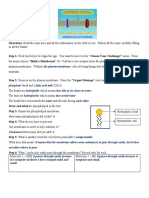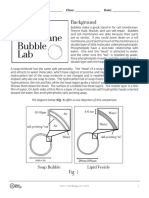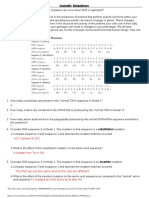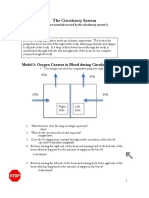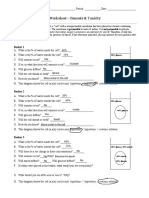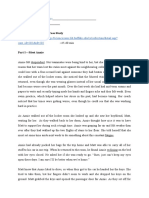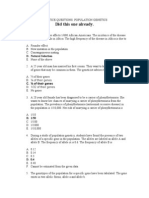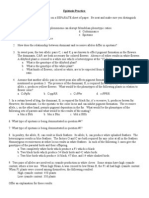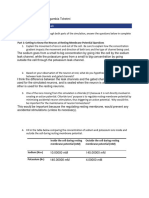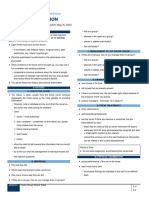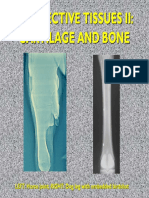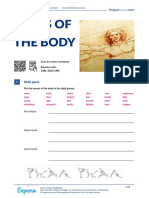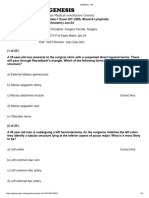Name________________________________________________ Periods_________ Date_____________ Action Potential Simulation
Background:
When a nerve cell is stimulated, it triggers what is known as an action potential. An action potential is the change in electrical potential
that propagates (travels) along the membrane of a nerve cell. This is how information moves through our nerves!
In this activity, you’ll be investigating the changes that take place in a nerve cell during an action potential. Pay close attention to the
locations and movement of ions, changes in electrical potential, and membrane proteins that are involved.
Getting Started:
Go to the following website: https://phet.colorado.edu/sims/html/neuron/latest/neuron_en.html
The image shown represents a cross-section of the nerve axon. (What’s a cross-section? Imagine laying a nerve cell lengthwise along an
x-axis and slicing through it along the y-axis: that’s how you get a cross-section!) The yellow represents the plasma membrane of the
axon. The myelin sheath is not shown here.
When you click “Stimulate Neuron,” you’ll notice a purple and yellow thing moving down the length of the axon: this represents the action
potential. What you’ll be observing in this activity is what happens when the action potential reaches this cross-section of axon. You are
not observing the entire nerve cell, just a tiny fraction of its membrane! The changes you observe here are what happen down the entire
length of the neuron.
In the box labeled “show,” start by checking all of the boxes. This will allow you to see everything that is going on. Hit the “Stimulate
Neuron” button on the lower right corner of the simulation to simulate an action potential. You can pause the simulation at any time, scroll
back on the potential chart to rewind, zoom in/out, and speed up or slow down the animation.
Take several minutes to play around with this simulation and get comfortable with it. What happens when you check or uncheck boxes or
click different buttons? You’re not going to break it, so go ahead and click everything!
After you’re comfortable with the various settings, use the simulation to answer the questions below. Pro tip: You’re going to need to
zoom in and change the speed to really understand what’s happening as you work through these questions.
When you’re ready to start answering questions, check ALL of the boxes in the section labeled “Show.”
1. Observe the membrane closely while the axon is at rest.
a. Which membrane channels are open? K+ and Na+ leak
b. Which are closed? K+ & Na+ gated
2. Are there more open or closed channels present in the membrane when the axon is at rest? Closed
3. The concentrations of sodium and potassium ions are different inside and outside the membrane. Which direction will sodium ions
move as a result of facilitated diffusion through the “leak” channels? Potassium ions? They both move in both directions, but more
potassium ions will be moving out and more sodium ions will be moving in.
4. Which side of the neuron is negatively charged - inside the neuron or outside? Inside
a. This simulation only shows positively charged ions. How can one side of the membrane have a net negative charge in this
scenario? What must be present but not shown in the image? Negatively charged ions are present but not shown.
5. Although facilitated diffusion is clearly happening, the indicated ion concentrations are not changing. That’s because this image is
actually missing a very important protein called the sodium-potassium pump! Think about what you know about the concentration
gradients. What must this pump be doing to maintain the concentration gradient? What kind of transport is it doing? Which direction must
each ion be moving through the pump? active transport; pumping K+ in and Na+ out
�Now it’s time to stimulate your neurons!
6. On the axes provided, sketch the graph that is generated when you click “stimulate neuron.” Include ALL necessary titles, labels, and
units! (This does not need to be perfect, so don’t bother writing every number or filling in grid lines.) Then, complete the table below by
writing the answer or circling the correct word. Pay close attention to +/- signs on the membrane potential values!
At Rest (0-2 ms) Peak of Action Potential Immediately After Action
(~2.7 ms) Potential (4 ms)
Membrane potential (mV) (These values are -70 35 -75
estimates based on the graph)
Which side of the membrane has a net negative
Inside / Outside Inside / Outside Inside / Outside
charge?
Which side of the membrane has a greater
Inside / Outside Inside / Outside Inside / Outside
concentration of sodium ions?
Which side of the membrane has a greater
Inside / Outside Inside / Outside Inside / Outside
concentration of potassium ions?
State of the gated channels? Open / Closed Open / Closed Open / Closed / Closing
7. When membrane potential is negative, which side of the membrane is negatively charged? What about when the membrane potential
is positive? Negative: inside, Positive: inside
8. What about the role of relative permeability of the ions? Before looking at that, let’s calculate the equilibrium (Nernst) potential of the
two ions.
9. Plugging in the concentrations of sodium and potassium, calculate the equilibrium potentials for sodium and potassium.
ENa+ = 72 mV EK+ = -96 mV
If the membrane potential is at the equilibrium potential for a specific ion, there is no net tendency for that ion to move in or out of the cell.
But what if the membrane potential is not at the equilibrium potential for a specific ion, and there are open ion channels that will allow the
ion to cross? The ion will tend to move across the membrane. If the ion is moving across the membrane (i.e. the membrane is permeable
to it), then the membrane potential should get closer and closer to the equilibrium potential for the ion. So, if the cell is more permeable to
sodium, the membrane potential will become closer to the equilibrium potential of sodium (ENa). If the cell is more permeable to potassium,
the membrane potential will become closer to the equilibrium potential of potassium (EK).
10. When the cell is at rest, is the membrane potential closer to the equilibrium potential of potassium or sodium ions? What about at the
peak of the action potential? At rest: closer to K+ At peak: closer to Na+
�11. Based on this information, predict the membrane’s relative permeability to sodium and potassium at rest, during the upstroke of the
action potential, and during the down stroke of the action potential. (Think about when the potential is approaching ENa+ and when it is
approaching EK+.) Explain your prediction.
At rest: K+ Upstroke: more permeable to Na+ Downstroke: more permeable to K+
When the neuron is at rest, the membrane potential (-70 mV) is much closer to EK+ (-96 mV) than it is to ENa+ (72 mV), which
indicates that the membrane is likely to be more permeable to K+ than to Na+. During the upstroke, the membrane potential tends
toward the ENa+, indicating increasing permeability to sodium ions. At the peak (35 mV) , the membrane is likely more permeable
to sodium ions than to potassium ions because the potential is closest to ENa+. During the downstroke, permeability to Na+ is
likely decreasing and permeability to K+ is likely increasing because the potential is moving away from ENa+ and toward EK+.
Observe the sodium and potassium ions passing across the membrane during the simulation. You might want to slow down the simulation
speed and use the zoom feature to get a closer view.
12. Which gated channel opens first (during the upstroke)? Na+
13. Which opens second (during the peak/downstroke)? K+
14. What direction are sodium ions moving through the sodium gated channel? What direction is potassium moving?
Na+ moves in, K+ moves out
15. What is happening to the membrane potential as each of these channels open?
As Na+ opens the potential is becoming positive
As K+ opens, it is becoming negative
16. Do these observations agree with your prediction in question 11? Explain.
Yes!
17. Look carefully at the graph of the membrane potential. At the bottom of the downstroke, what is the approximate membrane potential?
Is this higher, lower, or the same as the resting membrane potential? ~ -75 mV; lower than resting potential
18. Observe the “Stimulate Neuron” button throughout the course of the action potential. It turns gray, indicating that it is not available to
be clicked. This actually represents an important concept in neuron function, the refractory period. This is a period after the action
potential occurs during which a second action potential cannot be propagated. What is the membrane potential when you can stimulate
the neuron again? How does this compare to the resting membrane potential? It is back to resting - around -60 something
19. The drug ouabain inhibits the function of the sodium-potassium pump (explained in question 5). Predict the short-term and
long-term effects of ouabain on the excitability (ability to be stimulated) of a neuron. Think about the effect this would have on the resting
membrane potential.
If Ouabain is applied to a cell, the Na+/K+ ATP-ase could not pump sodium out of the cell and potassium into the cell to develop
a chemical gradient. This pump plays a role in mantaining a negative resting membrane potential. Therefore, there will be less
chemical gradient and electrical potential so sodium will not flow in and potassium flow out. The cell will then be unable to
depolarize or create an action potential, stopping the signaling process.
